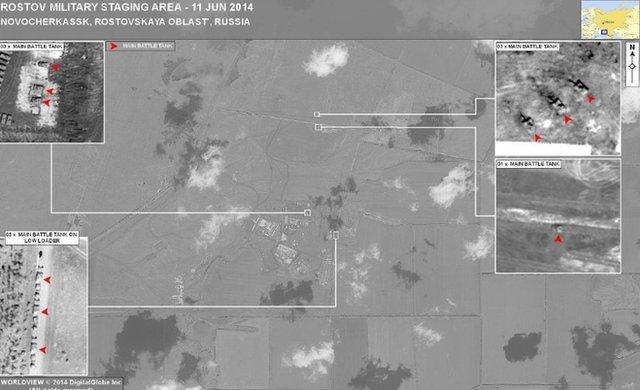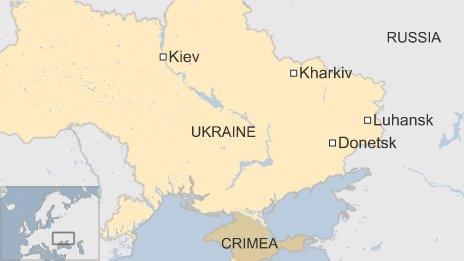Russia and Ukraine's mystery tanks
- Published

A lone T-64 battle tank is shown in Snizhne, Ukraine, with no markings
The Russian government has strenuously denied that any of its tanks crossed the border into Ukraine.
But now Nato has released satellite imagery, external, linked to existing video material, which appears to give added weight to assertions from the Ukrainian authorities that the tanks used by separatist forces that crossed into its country just a few days ago were indeed supplied by the Russians.
There is no doubt that the mystery tanks were on the road inside Ukraine.
Two of them were seen driving through the town of Makiivka, near Donetsk, and another was seen in Snizhne, further east.
Nato has provided two pictures from open-source video that show the T-64 tanks at the two locations.

Here an alleged T-65 is shown in Makiivka, next to a lorry with a Russian flag
The T-64 is a main battle tank that has been phased out of service in the Russian army, though Nato sources believe that many remain in storage and are still in an operational condition.
The Ukrainian army has similar tanks but its all carry identification signs and are painted in a camouflage pattern - unlike the tanks in the two pictures.
But where might the mystery tanks have come from? The Ukrainian government was quick to point the finger at Russia, and Moscow was equally quick to waive away the allegations.
Now Nato believes that its satellite images provides a clue.
Secret evidence
It should be noted that they come from civilian satellites. This is for two reasons: firstly, they can be verified with the satellite operator; and secondly, because getting clearance for the public use of images from the military is very difficult to obtain for fear of giving away capabilities.
A senior Nato officer told me, however, that military satellite material covering the same locations gives added evidence of Russian involvement.

The image Nato has released shows is Russian military staging area near Rostov-on-Don over a period of a couple of weeks (above). The first image, dated 30 May (on the left), shows a Russian army unit in position with large numbers of armoured vehicles but no tanks.
The next image in the centre, dated 6 June, shows that the unit has largely pulled out but a small number of tanks have arrived - eight in number.
By the third image on 11 June, there are 10 tanks gathered there. Some are parked and some are in a training area.
But the most interesting image is the next one - shown below - taken at the Rostov training area on the same day.

This shows three tanks loaded up onto transporters interspersed with other military vehicles. In other words, it looks like a convoy getting ready to go somewhere.
Nato has no doubt that this is the convoy that crossed the border into Ukraine, some of whose vehicles are shown in the videos.
The evidence shown comes from Nato military sources and is not necessarily conclusive. But, despite Russian denials, it is strongly suggestive of the narrative that Nato is setting out.
It should be noted that Russian spokesmen have denied a number of things in regard to operations in Ukraine which have turned out to be true.
A senior Nato officer told the BBC, that the images "raise significant questions concerning Russia's role in facilitating instability in eastern Ukraine".
